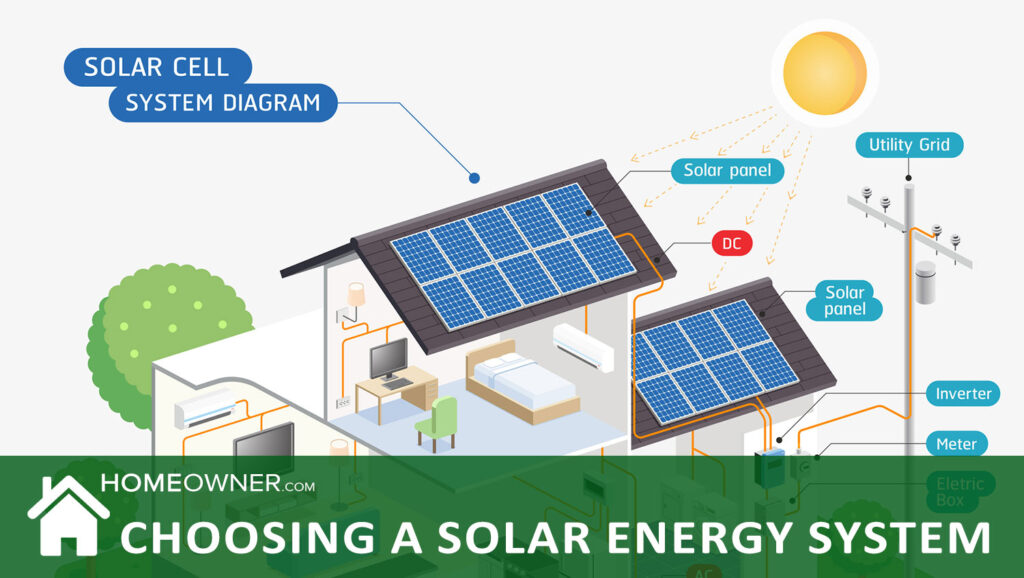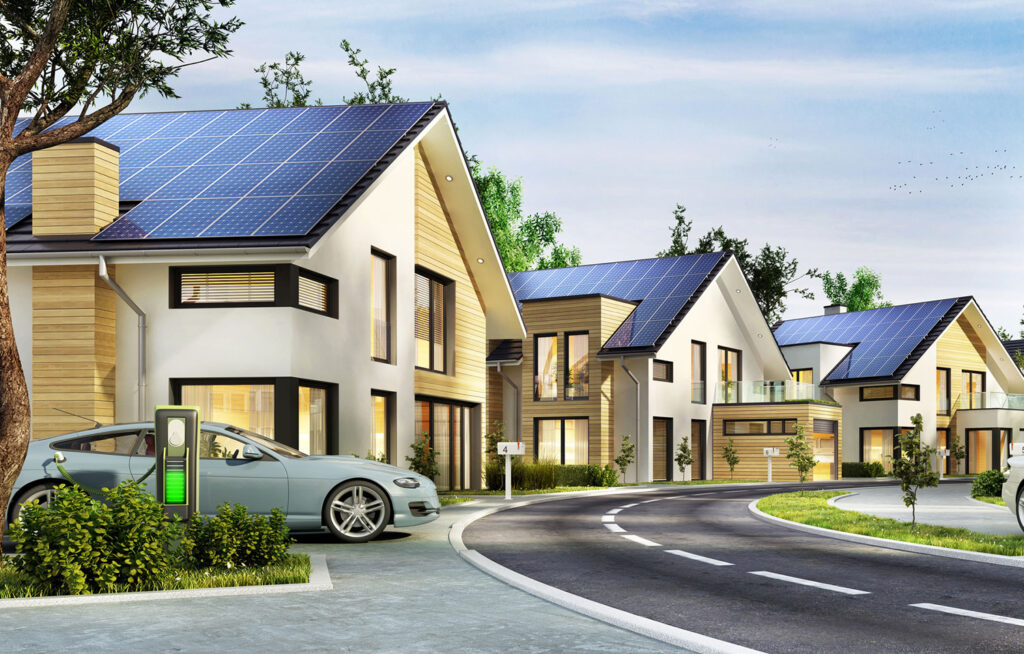Every day, the earth is bombarded with free energy in the form of sun rays. In fact, the sun radiates more energy in a single second than people have used since the beginning of time.
Solar power conversion is all about converting the sun's rays into electricity we can use.
Get A FREE Home Solar Quote Now
Actually, it's been done since the caveman days when they would use makeshift magnifying glasses to produce fire, cook their food, and stay warm.
Solar photovoltaic systems, often called solar PV for short, are made up of a number of components, the biggest and most important being the solar panels, solar inverters, mounting platforms, and cabling infrastructure.
Combined, these components harness radiant light from the sun, convert it into electricity and transmit it into homes and businesses to power electrical devices, like lights and appliances, and provide heating and cooling via the electrical currents they create. Here is a general overview of how solar PV systems work.
Solar Panels
The solar panels themselves are perhaps the most well-known of all the system components since they're the most visible part of the package, often perched atop homes and buildings. Solar panels are also considered the lifeblood of a solar power system, since the solar panels actually capture the sun's radiation, thereby initiating the entire process of converting sunlight into an electrical current. The job of solar panels is to essentially create the electrical current.
Solar panels can come in all shapes and sizes but are typically comprised of a grouping of solar cells that are wired together and encapsulated by a glass casing that protects the equipment against the elements. Solar cells are essentially made up of semiconducting materials – often silicon – that are sandwiched together between positive and negative charges.
When sunlight hits a cell, the photons within the sunlight knock electrons free from the semiconducting material. This starts the flow of electricity. Then, conductive plates made of metal on the sides of the cells gather the electrons and transfer them through wires. At this point, these electrons can flow just like any electrical current.
While there are a number of factors that determine the electrical output of a solar power system, the number of solar cells and overall size of the solar panel array, are the major determinants of how much electricity can be generated from a solar system. The more solar cells and the larger the solar panel array is, the more electricity can be generated.
The type of solar cells will also impact the efficiency with which a solar panel generates energy. Generally speaking, monocrystalline silicon is the most efficient material to use in solar cells. Polycrystalline silicon and thin film cells are also commonly used and are less expensive than monocrystalline.
Solar Inverters
Solar PV systems would be worthless without solar inverters – as such, many consider solar inverters the “brains” of the entire system. Once radiant sunlight is converted into electricity, solar inverters transform the electrical current from direct current (DC) power to alternating current (AC), so it can actually be used in various applications.
This step is necessary because solar panels cannot create AC power on their own and in the United States, most electrical devices run on DC power. In a DC system, the electrical current flows in one direction. By contrast, AC power is a bit more complex, moving in both directions, backward and forward.
Since the U.S. grid system actually works on AC power, solar inverters have the ability to convert electrical converts back and forth between DC power (used to power devices in the home) and AC power (to put electricity back onto the grid).
Typically, solar inverters are about 95% efficient, so they only lose about 5% of the electricity during the conversion process.
There are three general types of solar inverters:
- Stand-alone inverters are those that do not need to be plugged into an electrical device. Instead, they draw their charge from a battery powered by the solar PV system itself. These are often a good choice for non-grid tied systems.
- Grid-tied inverters are compatible with the utility grid. They're designed to shut down automatically in a black-out situation due to safety concerns. As such, grid-tied inverters cannot provide backup power during an outage situation.
- Battery backup inverters also draw energy from a battery, but what is unique about them is that they are designed to export excess energy back to the utility grid. In this way, they can supply AC currents during utility outages.
Cables and Wires
Next, a series of cabling infrastructure is necessary to actually bring the converted power into homes and businesses. In essence, the solar cable is a wire that interconnects all parts of the solar PV system.
Cabling networks can vary, but typically are designed to be UV and weather resistant and capable of dealing with extreme fluctuations in temperature (both heat and cold), since one common factor for these systems is that they're used outdoors. The most common type of cabling used is a DC voltage of 1.8 kV and a temperature range from – 40 degrees Celsius to 90 degrees Celsius. See our Solar Wiring Guide.
Another important feature of the solar cable is that it must be insulated well enough to withstand the thermal and mechanical loads. To achieve this, most solar cables use plastic that is cross-linked using electron beams. This protects against the weather elements, including the sun's radiation and humidity that would otherwise erode the system over time.
Mounting System
Finally, the mounting system is the skeleton of the solar power system. Mounting systems are the platforms upon which solar arrays reside. Most commonly, home and business owners mount their solar systems on top of their roofs so that they can gain greater access to direct sunlight. However, mounting systems can also be built on the ground or on other erected structures, like a pole.
Solar mounting systems must be installed according to local building codes. However, generally speaking, rooftop PV arrays are generally mounted parallel to the surface of the roof with just a few inches of space between the system and roof. Arrays are mounted at angles that enable them to optimize sunlight capture – i.e. closest to a 90-degree angle with the sun.
Ground-mounted systems are typically used by utility companies to generate larger amounts of electricity to be deployed onto the grid. Ground-based mounting systems include pole mounts, foundation mounts, and ballasted footing mounts to secure the arrays firmly to the ground. In some cases, ground-mounted systems are designed to provide some type of shade, such as a patio cover or even a parking garage cover.
How Solar Panels Work
Solar panels work by collecting solar energy from the sun. How well they work depends on how much light energy they get via the solar cells.
Solar cells are typically combined to make solar panels, otherwise known as PV panels, solar modules, or PV modules. One or more of these panels grouped together constitutes a PV array or solar array.
Solar panels are used to convert solar photovoltaic energy into DC (direct current) electricity. A power inverter is then used to convert that DC electricity to AC (alternating current) electricity, which is what we use in our homes.
How Solar Works In Your Home
Your solar panels gather energy from the sun and send it to your photovoltaic components (inverter), which convert it to AC power.
AC power then enters your home through the utility panel and is distributed to appliances or lights in the house.
If you don't go through your breaker panel, you can also access the power by plugging appliances directly into the inverter's power sockets.
However, if your system is connected through the utility panel, all the excess electricity created after your battery bank is full (provided you are using a battery bank) can be exported back into the utility grid and credited to your electric account. If you used a big enough solar system, you could make your utility meter spin backward.
This is how solar energy works in your favor when you hook up to the grid and actually make money (in the form of an energy credit) from your utility company.
Storing Solar Power
Deep cycle solar batteries are needed to store any solar energy not being used. This power reserve can then supply your home with electricity at night, in times of cloudy weather or in the event of a blackout or power outage.
Solar power can be used to power your lights, your appliances, your central heating, your hot water heater or any other household loads.
An efficiently solar powered home can make about 75 to 100% of its own power and with the option to feed “surplus electricity” back into the grid can accumulate an energy credit from the power company, meaning the occupants may never have to pay for electricity again.
Solar PV Technology
Solar Photovoltaic (PV) panels are made up of multiple PV cells. Cells are semiconductor devices that convert the energy from the sun directly into electricity.
The heart of almost all semiconductor devices is the PN junction, the junction between negatively charged N-type material that has a surplus of electrons, and positively charged P-type material that has a deficiency of electrons. When photons of light strike the junction, energy is imparted to the electron and it is released to be able to flow as electrical current.
There are two electrodes that make electrical contact with the cell. The electrode on the top surface is made up of very fine wires. It must contact as much of the N-type material as possible but it also must minimize blocking the light photons. The bottom contact is a solid foil-like conductor.
Because electrons reside in the N-type material, the thicker the layer of N-type material (usually silicon) the more electrical potential a cell will have. But, because the N-type material is the side of the cell that is exposed to the sun, as this layer gets thicker, fewer photons of light will be able to penetrate to the PN junction.
Monocrystalline
Monocrystalline PV cells are sliced from a single, homogenous ingot that has been drawn slowly from molten silicon. This gives the cells a dark, uniform appearance. Cells are then cut into squares to maximize the surface area when connected together to form a panel, and the conducting layers are applied. Many PV manufacturers, including Conergy and Schuco, are publishing module efficiencies in around 15% for both mono and polycrystalline panels of comparable designs.
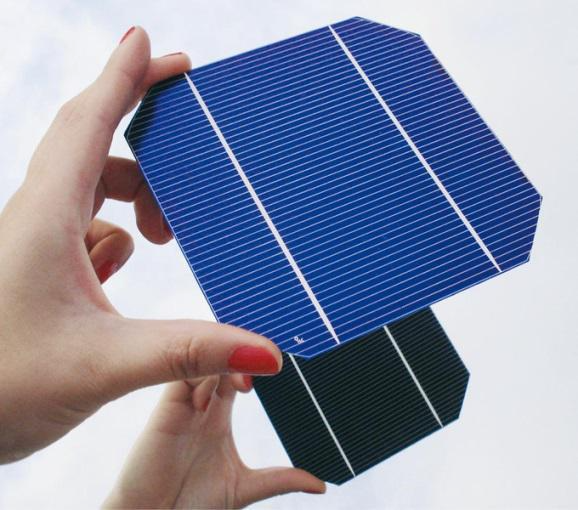
Polycrystalline
Polycrystalline cells are sliced from an ingot that has been made by casting many silicon crystals together. This gives the cells a multi-faceted appearance. Polycrystalline and monocrystalline PV panels are, together, the workhorses of the Solar PV industry, being used in all aspects of the industry from large solar farms to off-grid homes to mobile, self-powered applications such as traffic signs. They both come complete with their own structural frame which makes the task of mounting them easier and cheaper.
Both monocrystalline and polycrystalline panels have a high power density, compared to other options in the PV industry. They are a good choice for roof-mounted arrays where space is at a premium.
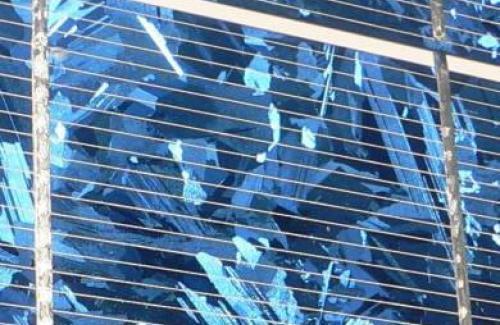
Thin-film PV
Thin-film cells can be made of a layer of amorphous silicon or other materials such as cadmium telluride. The layers are very thin because they are made using a vapor depositing process that results in layers much thinner than those used in mono or poly cells.
Since the layer of silicon that the light photons must penetrate is thinner, thin-film cells have a higher efficacy when the sun's radiation is weaker such as during cloudy, overcast conditions or in seasons where the sun is lower in the sky. The trade-off is that thin-film panels have a lower power density, meaning it takes more surface area of this type of panel than mono or poly panels to make the same amount of energy in good conditions.
A characteristic of thin-film panels for commercial power generation is that they are often made without a structural frame which increases the time, difficulty, and cost of mounting them. This additional cost offsets the savings achieved in the manufacturing process.
Amorphous panels are used almost exclusively on solar farms where there is no limitation on the size of array. Thin-film cells are flexible and can be made into flexible panels and fastened to curved surfaces with adhesives. Thin-film panels' flexible characteristics make them a good choice for Building Integrated PV (BIPV) applications, for flat membrane roofs or sloped steel roofs. Flexible thin-film panels are also seeing a surge in popularity for Recreational Vehicles and the sailing community.
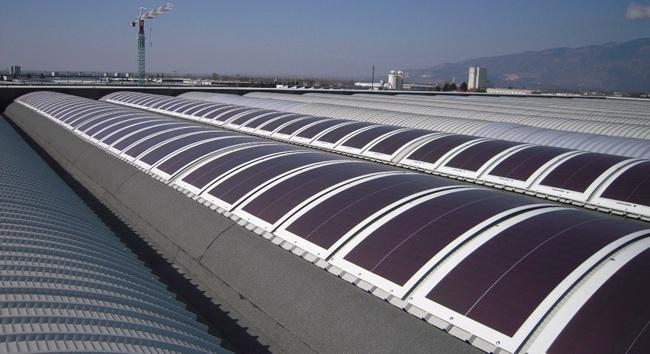
Emerging Technologies
Most research in the solar industry is focusing on improving existing technologies in mono or polycrystalline cells. Another focus is on concentrating solar radiation on fewer cells in an attempt to reduce the overall cost by replacing expensive PV cells with cheap reflectors or Fresnel lenses. But most companies trying this have been unable to overcome the loss of power from PV cells as the temperature increases.
A new technology that is winning awards is attempting to use “organic solar cells” following the lead of Organic Light Emitting Diodes (OLEDs) in the LED and television industry. The cells are reported to be 1/10th the thickness of a thin-film PV cell, making them virtually transparent.
The transparent property of the new cells allows them to be used on window surfaces, absorbing some of the sun's radiation before it has a chance to penetrate buildings, often adding to the air-conditioning load. However, they are so transparent that it will not affect the clarity of the windows. However, there are currently no commercial products available.
Solar Roof Tiles
What are solar roof shingles and how do they work?
PV Solar Tiles
Solar tiles (also known as solar roof shingles, roof shingles, solar roof tiles, and building integrated photovoltaic panels – BIPV) are an incredible breakthrough in solar technology that is changing the way people are thinking about solar power.
These solar shingles look just like regular roof shingles, but they are lined with a thin crystalline solar film (PV panel) that harnesses energy from the sun all day long.
Benefits of Solar Shingles
With a great combination of durability and power, some of these solar shingles can produce up to 50 watts of electricity each without anyone even knowing they are there.
This may not sound like the most energy, but once you multiply it by the entire square footage of a roof (covered with solar roof shingles), it can definitely add up fast.
Additionally, solar PV tiles have superior structural support and can typically withstand wind speeds of up to 80 mph and much more.
Since PV solar tiles are right up against your roof, wind can't get underneath them as easily as with traditionally mounted solar panels.
Installing Solar Roof Shingles
Solar tiles can be attached to your roof via interlocking units or they can be nailed or screwed on. Solar roof shingles are installed flush with your regular roof shingles and fit the exact dimensions of your roof.
One unique feature of solar shingles is that they don't need to be angled to directly face the sun. PV solar tiles produce electricity just as long as there's some daylight and thus can be used on both the front and back sides of your roof.
Esthetically speaking, solar shingles blend right into the style and architecture of your home and provide all of the benefits of solar power without standing out like traditional solar panels.
Less Maintenance, More Power and Undetectable
Sometimes solar roof shingles can look so natural that it's virtually impossible to differentiate them from traditional roof tiles.
Solar shingles make solar installation much more straightforward and the maintenance simpler since you no longer have to clear leaves and snow from under the panels like with bracket or rail mounting systems.
Although solar roof tiles are more expensive (partly because they are newer), they can really pay off in the long run when you make more power, save more money, and raise the value of your home due to a more aesthetically pleasing look.
How Solar Power Works
Solar power is a renewable energy source that can be collected from the atmosphere and converted into the type of power we need to run our homes and our lives.
Solar power is created when the sun's radiant energy (speeding photons) hits the surface of a semiconducting material such as silicone (commonly used in solar cells).
As a result, electrons are knocked loose from their atoms, which allows them to flow through the material in the solar cell to produce electricity.
This process whereby light (photo) is converted into electricity (voltage) is known as the photovoltaic (PV) effect. Solar energy works to create usable electricity by combining nature (the sun) and man-made objects (PV cells).
Solar energy is efficient, affordable, and easily harvested, which in a nutshell means it works great. Learn more by researching the best solar companies and finding an solar installer in your area.
With the advancement of solar power technology, it's sure to work even better in the future and as a result, more households will be able to benefit from this free form of energy with much fewer technical or financial obstacles.


